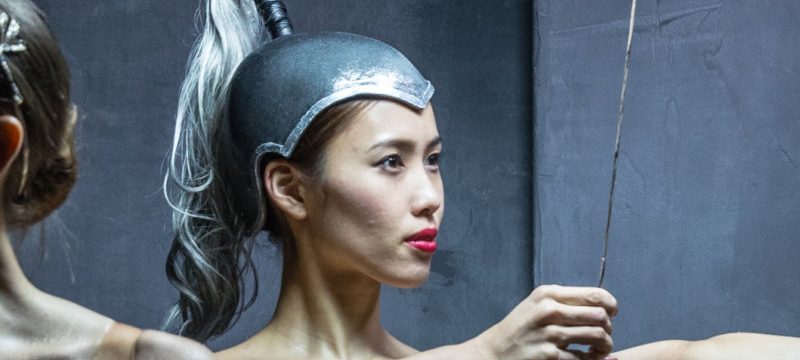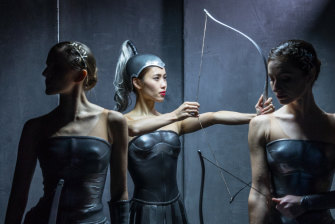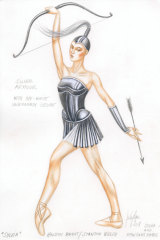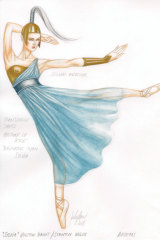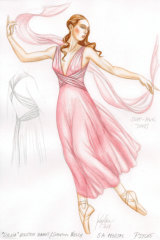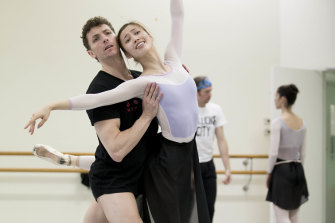Stanton Welch speaks about the three “superheroines” of his convention-busting ballet, Sylvia, with awe and infectious energy. Each of his characters breaks the mould for traditional classical leads, none is a damsel, victim or coquette, in fact two are impressively “weaponised”.
In this retelling of a rarely performed tale of Greek goddesses and mischievous deities, the women carry the narrative, do the muscle work and rescue themselves – they have so much agency that the work sounds in many ways like a perfect, high-art response to the message of female empowerment delivered by #MeToo. At one point, warrior “wonderwoman” Sylvia wins the day in a swordfight (real sword) as the shepherd with whom she has been tricked into falling in love shelters behind her.
“This is a female character-driven ballet. Very deliberately, when we were making the ballet, it was important that each of the three female leads, all of equal measure, had the governance and the guidance of each of their stories,” says Welch, the Australian Ballet's resident choreographer, and for 16 years the artistic director of the Houston Ballet.
Welch'sworks are usually recognised for their technical difficulty and the demands they place on dancers, but for Sylvia he went to lengths to help the cast of both this Australian premiere production, and Houston's world premiere earlier this year, to re-learn the subtle art of how men and women relate physically on the stage.
To illustrate the fact the women are in charge, most aspects of the male-female interaction had to be turned on their head; who helps who up from the floor, who draws who in for a kiss, even how each grips the body of the other during a Pas de deux.
Australian Ballet dancers Corey Herbert, Ako Kondo and Imogen Chapman in costume for Sylvia. Credit:Simon Schluter
“The role of Sylvia and the shepherd was remarkably difficult,” says Welch, who worked intensively with the AB cast, including principal artist, Ako Kondo (Sylvia), principal Robyn Hendricks (Artemis) and senior artist Benedicte Bemet (Psyche), in July. “We did a lot of things with the partnering; the hand grips, when you hold hands whose is the dominant hand and whose is underneath – how you kiss someone, reversing it … she leads him in for a kiss.”
Designer Jerome Kaplan’s sketch for Sylvia and the nymphs.Credit:Australian Ballet
The ballet tells the story of three protagonists in ancient Greece forced to balance passion with duty. Sylvia, the fighter, is charmed into dropping her defences when Eros casts a spell upon her to fall in love with the first man she sees (only to regain her chutzpah later, but remain with her faithful shepherd).
Artemis is a goddess who, having been tricked into killing her dear friend, Orion, dedicates her life to her work, and Psyche is a mortal beauty who defies a promise to her suitor, the disguised god Eros, never to look under his mask. The plot lines may sounds soap-operatically Greek, but Welch insists the story of each woman is one of authentic strength.
Jerome Kaplan’s sketch for Artemis.Credit:Australian Ballet
Sylvia is the dominant partner in her relationship, Artemis chooses to be celibate and focus on her mission after losing Orion, and Psyche is a rebel.
Of the three, Psyche is the more typical “girly girl” heroine, but even so she “is the one that goes on the adventure, she is the one that conquers Aphrodite, she's the one who goes to hell and back to get [Eros] back. So, even though she's a very feminine character, she's very much the driving force behind everything, and her curiosity and feistiness is very much part of the story”.
Ako Kondo, who most recently wowed Australian audiences as the girlish lead in the ballet's celebrated The Adventures of Alice in Wonderland (a work of two hours and 41 minutes in which she had about four minutes off stage), says there were plenty of challenges along the way to mastering Sylvia.
“In the ballet, the female roles are usually always feminine, weak, fragile; Sylvia is very opposite to that; she actually acts like a man to her love – even holding hands, you do it the ‘man way’. The way I am dancing with Kevin [Jackson, who plays the shepherd], and acting more ‘strong’ – and I even get to do a bit of swordfighting – is brand new. I have never done any swordfighting on stage in ballet, it's always the boys doing it, like in Romeo and Juliet,” Kondo says.
Jerome Kaplan’s sketch for Psyche.Credit:Australian Ballet
She confesses to being naturally “shocking” at swordswomanship and to needing a bit of weight training on one arm to develop enough muscle to wield the weapon in the way Welch required. “I also researched by watching a TV series with Samurais fighting, and asked my husband [Australian Ballet dancer Chengwu Guo] what he thinks the male dancers’ natural movements for swordfighting are. Because they do it all the time [seen to spectacular effect, for example, in last year's revival of Spartacus].”
For the record, his advice was “don't think it is just about using your arms; the action happens from your body to your arm”. Kondo says that tip helped transform her movement; “Stanton was like, ‘Oh, great, you've done some homework’.”
Other homework, as suggested by the choreographer, was to watch the recent movies Wonder Woman, starring a very buff Gal Gadot, and Captain Marvel, starring Brie Larson. She also had to learn to stand at ease with her feet “never together, always apart – and quite wide”.
For Welch, the “son of a single mother”, the legendary Australian ballet dancer and artistic director, Marilyn Jones (his father is choreographer and dancer Garth Welch), creating strong women leads was no stretch. “I have [created] a Cinderella who doesn't choose the prince, she disowns the prince and picks the servant, which I made here 20-odd years ago, even [his] Butterfly is quite a strong woman; she makes decisions and she struggles against the community and society's wishes.
“So I like that very much. People said to me, ‘Why?’ and, like I was raised by a single mum who was a director and principal dancer, so I don't know any other world than that – women ruled.”
He mentions the Australian Ballet’s founding artistic director, Dame Peggy van Praagh, and also longtime AB artistic director Maina Gielgud, as other aesthetic influences of his childhood. Given his long-time admiration for strong female characters, Welch says it is more of a happy coincidence his Sylvia, with its trio of women on top, rather than strategic timing – given the currency of discussions around equality happening across Western countries in the past two years – that drove him to create Sylvia. The work was in the planning for three years.
Whatever the motivation (Welch insists Sylvia is not his direct response to #MeToo) principal dancer Robyn Hendricks, who plays the the forthright Artemis, says she very much appreciates playing such an independent and powerful woman. “I feel like it relates to where society is at at the moment, with all that's going on in the world … it’s a great time to do this role,” she says.
“She's the lead huntress and has an army of huntresses; bow and arrow is their thing, and she has given up a lot in her life to pursue this hunting. She's given up men and romantic relationships – which is something you do see [a glimpse of] in her relationship with one of her best friends, with whom she obviously feels very close.
“But she knows she cannot pursue that relationship because she has given up love to pursue the life of this powerful woman that she is.”
Hendricks says Welch's choreography, set to the1876 music of Léo Delibes, which has been described as one of the world's most stirring scores, was as challenging as his reputation suggests it could be. “Stanton is renowned for his tricky partnering and really difficult combinations; really challenging the dancers’ technique.
Ako Kondo and Kevin Jackson during rehearsals for Sylvia. Credit: Lynette Wills
“That's what I really love about doing his work; he does set the standard and the bar quite high and he never waives where that bar is. Everyone has to work up to that, it’s challenging and amazing what everyone can achieve when it’s so high.” Hendricks, who performs as Sylvia in the second cast, says that in her 15th year with the company and her third as a principal, to dance in ballets that “put new expectations on yourself” is rewarding.
Benedicte Bemet testifies to the technical sophistication of the work. “As dancers, we love that; everyone loves a challenge. The partnering for the main couples is quite complex, lots of the things – the lifts – we haven't done before. It is quite complicated, and not always your traditional ballet lifts.” She says the beauty of the score, which the great composer Tchaikovsky famously said was superior to anything he had written,is also a huge attraction.
For Welch, though, it seems the chance to shake up some of conventional ballet’s immutable rules is perhaps the greatest treat. “We even went so far as the bows; all the men receive flowers as well as the women, the man goes to collect the conductor instead of the woman – so we're just trying to break every level of sexism, with role reversal, that we have imprinted on ballet.”
Sylvia is at Arts Centre Melbourne, August 31-September 10, and Sydney Opera House, November 8-23. australianballet.com.au
Source: Read Full Article
